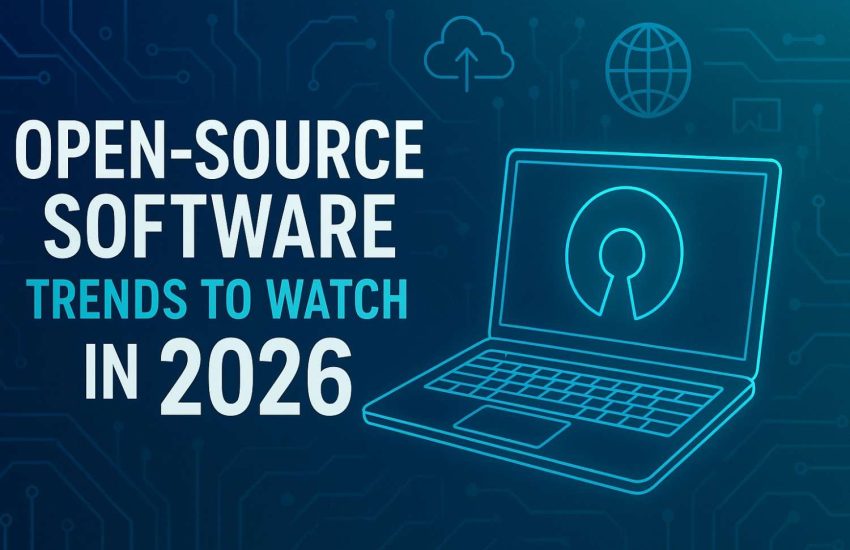Open-source software continues to be the driving force behind digital transformation. From powering artificial intelligence to enabling decentralized applications, open-source is reshaping industries in real time. As we move into 2026, businesses, governments, and developers are leaning on open-source tools for cost efficiency, transparency, and innovation.
In this blog, we’ll explore the top open-source software trends for 2026, highlight their global impact, and explain how companies can leverage them for growth.
Why Open-Source Is Unstoppable in 2026
Unlike traditional proprietary software, open-source provides:
- Accessibility: Anyone can use and adapt it.
- Security: Transparent code helps detect and fix vulnerabilities quickly.
- Collaboration: Global communities improve software faster than closed teams.
- Scalability: From startups to enterprises, open-source fits all.
With the rise of AI governance, data privacy laws, and green computing, open-source is becoming the default choice for innovation.
Top Open-Source Software Trends in 2026
Here are the biggest open-source software trends shaping 2026:
1. AI-First Open-Source Platforms
In 2026, AI-driven development dominates the open-source space. Frameworks like PyTorch, TensorFlow, and Hugging Face are evolving into AI-first ecosystems with tools for generative AI, natural language processing, and edge deployment.
- Trend: AI agents built on open-source frameworks are replacing traditional automation.
- Example: Open-source LLM (Large Language Model) frameworks optimized for industries like healthcare and finance.
2. Decentralized Cloud & Web3 Integration
The Web3 and decentralized cloud movement has matured by 2026. Instead of relying only on Amazon, Google, or Microsoft, companies are adopting open-source decentralized clouds like IPFS, Filecoin, and Ethereum-based platforms.
- Benefit: Cost savings and greater data ownership.
3. Quantum-Ready Open-Source Security
With quantum computing moving closer to mainstream adoption, open-source communities are building quantum-resistant cryptography.
- Tools: Open Quantum Safe (OQS) and PQCrypto projects.
- Trend: Governments and financial institutions adopting open-source post-quantum encryption.
4. Sustainable & Green Open-Source Projects
Sustainability is no longer optional. In 2026, open-source projects are leading the charge with energy-efficient data centers, low-power AI models, and eco-friendly IoT frameworks.
- Example: Green Software Foundation pushing for carbon-neutral open-source frameworks.
5. Low-Code & AI-Assisted Development
The low-code and no-code revolution has entered a new phase with AI copilots integrated into open-source development.
- Tools: Appsmith, Budibase, NocoDB, now paired with AI assistants.
- Trend: Citizen developers using AI + open-source platforms to build complex apps.
6. Global Collaboration Through Open-Source Governance
In 2026, governments and enterprises are embracing open-source governance models to ensure software accountability.
- Example: The EU and U.S. launching joint funding programs for secure open-source software.
- Trend: Public sector adopting open-source ERP and digital identity solutions.
7. Edge AI & Open-Source IoT
Edge computing is booming in healthcare, logistics, and retail, and open-source frameworks like KubeEdge and EdgeX Foundry are powering real-time decision-making.
- Trend: AI at the edge reduces latency for smart devices.
Global Impact of Open-Source in 2026
- North America: Driving AI + open-source research.
- Europe: Focused on data privacy and green open-source software.
- Asia-Pacific: Leading in Web3 adoption, edge computing, and IoT solutions.
- Africa & Latin America: Using open-source for affordable digital transformation in healthcare, finance, and education.
Challenges Ahead for Open-Source
Despite rapid growth, challenges remain:
- Funding: Many projects lack sustainable financial support.
- Security: Open-source still needs stronger AI-powered vulnerability monitoring.
- Regulation: Governments are starting to impose compliance standards on open-source projects.
How Businesses Can Prepare for 2026
To stay competitive, organizations should:
- Adopt AI-first open-source tools for productivity.
- Invest in quantum-ready cybersecurity frameworks.
- Leverage decentralized cloud & Web3 for global operations.
- Commit to sustainable open-source solutions to meet regulations.
- Encourage workforce upskilling in open-source development.
Conclusion
By 2026, open-source is no longer a secondary choice — it’s the default foundation for innovation. From AI-first platforms and decentralized clouds to quantum-ready security and green software, open-source trends are shaping a future where technology is more transparent, sustainable, and accessible worldwide.
For businesses, developers, and governments, embracing these open-source software trends in 2026 is the key to staying relevant, secure, and future-ready.

